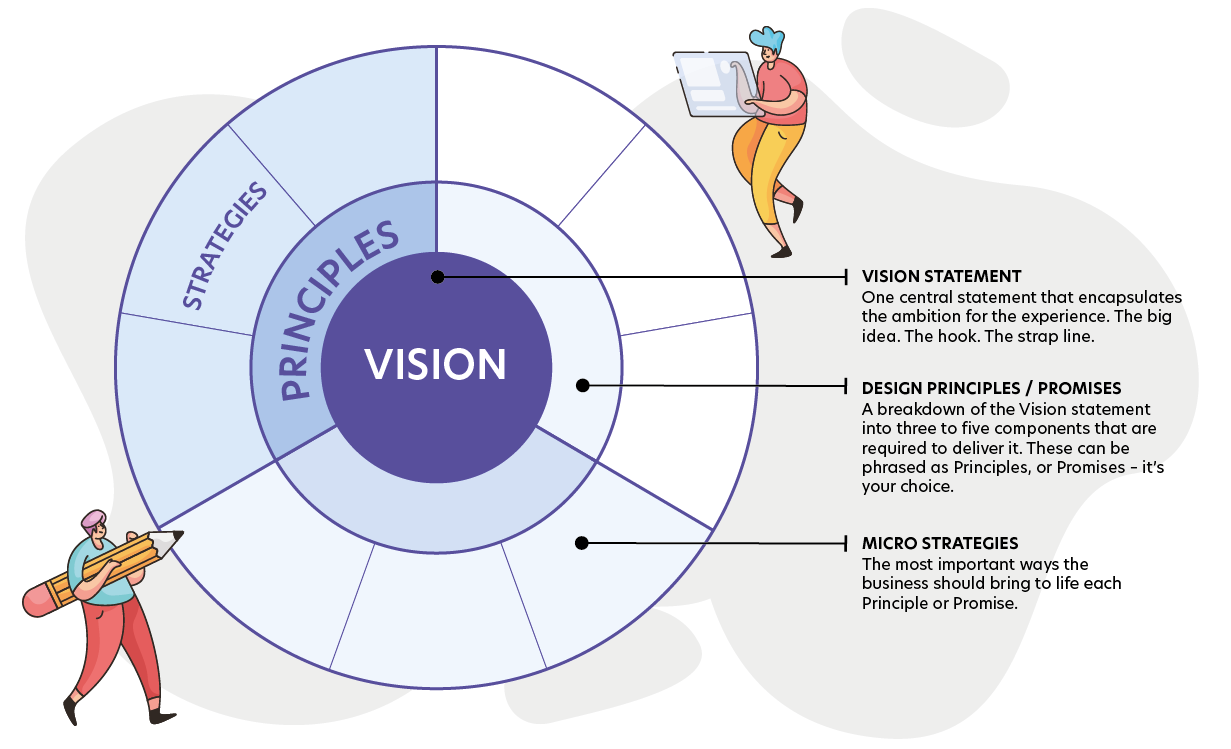Get in touch
9 Steps to create a compelling vision

This is the second in a series of 5 Blogs, where we explore 5 key tools in the Service Designers Toolkit – Customer Personas, Customer Journey Mapping, Visioning, Concepting and Service Blueprinting.
The service design process works best when all stakeholders are invested in it at an early stage. It’s vital for brands to stand out and provide excellent customer experiences. This can only be done effectively by taking a holistic view and designing with the target customer in mind. For service design, this can sometimes seem a little intangible at the start of the process. It can therefore sometimes be difficult for senior members of an organisation to buy into the process when they need to.
The vision wheel provides information at an early stage in a service design project and is useful for helping senior people quickly understand the direction being taken. They will need to both sign-off and sign up to the next steps if it is to succeed.
What is a vision wheel?
A vision wheel provides a framework that is described on one page. It shows the design principles that will direct the next steps of idea generation and customer experience design. Using words and images it sets out the essence or ‘DNA’ of the service and experience that is being created.
A vision wheel contains a vision statement, the principles or promises required to deliver it, and the tactics that will be employed to achieve the result. It expresses a clear 'feeling' about the qualities of the service and experience that is being created and it should be aligned with a brand’s framework. It can be created by one person, a few key people, or via a group brainstorming session: it’s up to you.

9 Steps to Create an effective Vision Wheel
-
- Begin capturing your thoughts from the start of the service design process.
- Understand the strategy, needs, values, and key competencies or competitive advantages of your brand as they will be reflected in the vision wheel.
- Understand what qualities customers should get from the experience and what is important for the business to achieve from it.
- Create the vision statement – this is the central statement that encapsulates the ambition for the experience. It is not a marketing tool or for customers so doesn’t need to be overthought. It can sometimes take a while to define.
- Determine the principles/promises – these are the three to five components that sit around the vision statement and are required to deliver it. Some may be more functional, others more emotional.
- Describing the tactics – tactics sit around the principles or promises and should match with them to give a tangible method of delivering on the statement.
- A service ‘feeling’ can be added to the vision statement. This captures how people will feel when they experience the new service.
- Bring the vision wheel to life and make it more memorable and compelling with interesting iconography and imagery.
- Once you have your finished vision wheel, take a step back from it and make sure you can sum it up in a sentence or two.
Now what?
Creating and signing off the vision wheel gives the team in charge of the project and the other stakeholders confidence that the insights, objectives, and drivers are reflected in the service being designed. It provides clear direction for the next stages of idea generation and experience design.
Click here to discover How Target Customer Journey Mapping Can Revolutionise The Customer Experience
Because the wheel describes the target it can be used to identify any gaps in the existing experience that do not meet with the vision. Performance measurement metrics can be mapped around the wheel where possible and appropriate – and competitor data as well if you have it.
The vision wheel continues to provide a useful reference even after initial launches of a service. It can help teams to assess proposed additional features or initiatives and discuss whether they fit with the vision statement.
The Engine Service Design team is here and ready to help you reimagine the future and unlock new value. Get in Touch if you need a trusted partner to discuss your challenges: one of our service design experts will be delighted to help.
6 Reasons customers personas can help you create experiences your customers love
This is the first in a series of 5 blogs, where we explore 5 key tools in the Service Designer's...A Masterclass in Perfecting Your Personas
In customer experience and business strategies, 'customer personas' have become pivotal in shaping...Four tips for designing beautiful services
1. Understand in detail what your services are made of A beautifully designed service is made up of...Book time with a service design expert.
Discover the transformative power of service design and unlock the full potential of your business. Get in touch with our service design experts today and start improving or innovating your services and customer experience.
